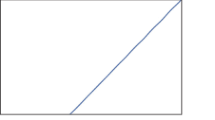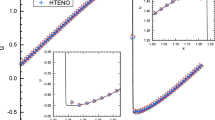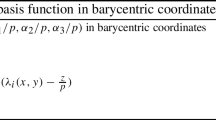Abstract
Conservative-characteristic schemes for the numerical solution of systems of hyperbolic equations combine the advantages of shock-capturing conservative methods and the method of characteristics. They operate with two types of variables: conservative and flux. Conservative variables have the meaning of mean values, refer to the middle of the cells, and are calculated using the finite volume method. The flux variables determine the fluxes on the faces of computational cells and are calculated using the characteristic form of equations and local Riemann invariants. This part of the algorithm allows various implementations, on which the dissipative and dispersion properties of the algorithms depend. For example, in the CABARET scheme, the flux variables are calculated by linear extrapolation of local invariants, but there are also schemes with interpolation of invariants and their subsequent transfer along the characteristics (active flux schemes). In the latter case, various options are also possible. This article is devoted to the results of the study of a possible variant of interpolatory conservative-characteristic schemes for systems of hyperbolic equations.













Similar content being viewed by others
REFERENCES
A. G. Kulikovskii, N. V. Pogorelov, and A. Yu. Semenov, Mathematical Aspects of Numerical Solution of Hyperbolic Systems (Fizmatlit, Moscow, 2001; Chapman and Hall/CRC, London, 2001).
V. M. Goloviznin and B. N. Chetverushkin, “New generation algorithms for computational fluid dynamics,” Comput. Math. Math. Phys. 58 (8), 1217–1225 (2018).
E. Guerrero Fernandez, M. J. Castro-Diaz, and T. Morales de Luna, “A second-order well-balanced finite volume scheme for the multilayer shallow water model with variable density,” Mathematics 8 (5), 848 (2020).
V. M. Goloviznin, M. A. Zaitsev, S. A. Karabasov, and I. A. Korotkin, New CFD Algorithms for Multiprocessor Computer Systems (Mosk. Gos. Univ., Moscow, 2013) [in Russian].
S. A. Karabasov and V. M. Goloviznin, “Compact accurately boundary-adjusting high-resolution technique for fluid dynamics,” J. Comput. Phys. 228 (19), 7426–7451 (2009).
V. M. Goloviznin and A. A. Samarskii, “Difference approximation of convective transport with spatial splitting of the time derivative,” Mat. Model. 10 (1), 86–100 (1998).
V. M. Goloviznin, P. A. Mayorov, and P. A. Mayorov, “Hyperbolic decomposition for hydrostatic approximation of free surface flow problems,” J. Phys.: Conf. Ser. 1392, 012035 (2019).
V. M. Goloviznin, Pavel A. Maiorov, Petr A. Maiorov, and A. V. Solovjev, “New numerical algorithm for the multi-layer shallow water equations based on the hyperbolic decomposition and the CABARET scheme,” Phys. Oceanogr. 26 (6), 528–546 (2019).
P. G. Yakovlev, S. A. Karabasov, and V. M. Goloviznin, “Direct modeling of the interaction between vortex pairs,” Math. Models Comput. Simul. 4 (3), 288–296 (2012).
D. Y. Gorbachev and V. M. Goloviznin, “The balance-characteristic numerical method on triangle grids,” J. Phys.: Conf. Ser. 1392, 012036 (2019).
V. M. Goloviznin and S. A. Karabasov, “Nonlinear correction of the CABARET scheme,” Mat. Model. 10 (12), 107–123 (1998).
B. Van Leer, “Towards the ultimate conservative difference scheme: IV. A new approach to numerical convection,” J. Comput. Phys. 23 (3), 276–299 (1977).
T. A. Eymann and P. L. Roe, “Active flux schemes,” 49th AIAA Aerospace Sciences Meeting Including the New Horizons Forum and Aerospace Exposition (2011). https://doi.org/10.2514/6.2011-382
V. M. Goloviznin and V. A. Isakov, “Balance-characteristic scheme as applied to the shallow water equations over a rough bottom,” Comput. Math. Math. Phys. 57 (7), 1140–1157 (2017).
N. A. Afanasiev and V. M. Goloviznin, “A locally implicit time-reversible sonic point processing algorithm for one-dimensional shallow-water equations,” J. Comput. Phys. 434, 110220 (2021).
Funding
This work was supported by the Russian Science Foundation, project no. 18-11-00163.
Author information
Authors and Affiliations
Corresponding authors
Ethics declarations
The authors declare that they have no conflicts of interest.
Additional information
The text was submitted by the authors in English.
Rights and permissions
About this article
Cite this article
Afanasiev, N.A., Shagirov, N.E. & Goloviznin, V.M. Interpolatory Conservative-Characteristic Scheme with Improved Dispersion Properties for Computational Fluid Dynamics. Comput. Math. and Math. Phys. 62, 1885–1899 (2022). https://doi.org/10.1134/S0965542522110021
Received:
Revised:
Accepted:
Published:
Issue Date:
DOI: https://doi.org/10.1134/S0965542522110021




